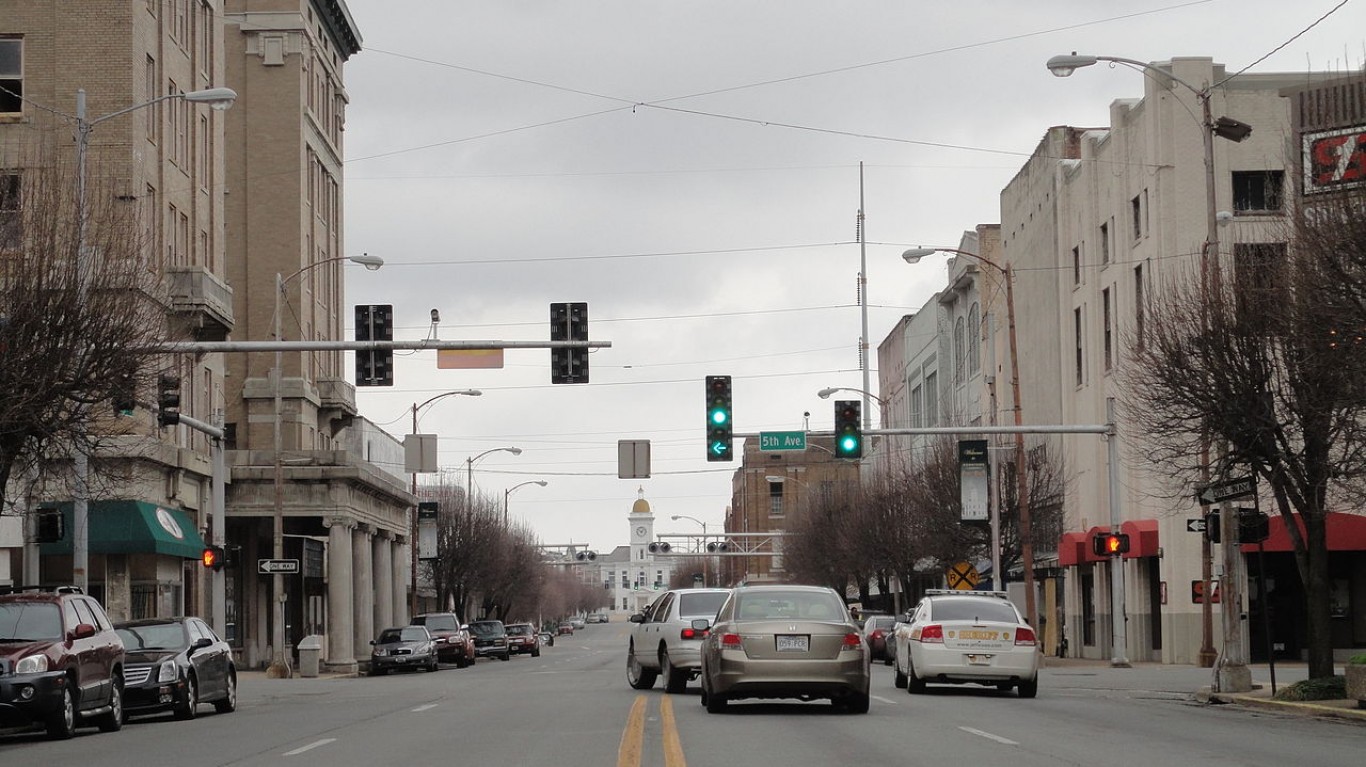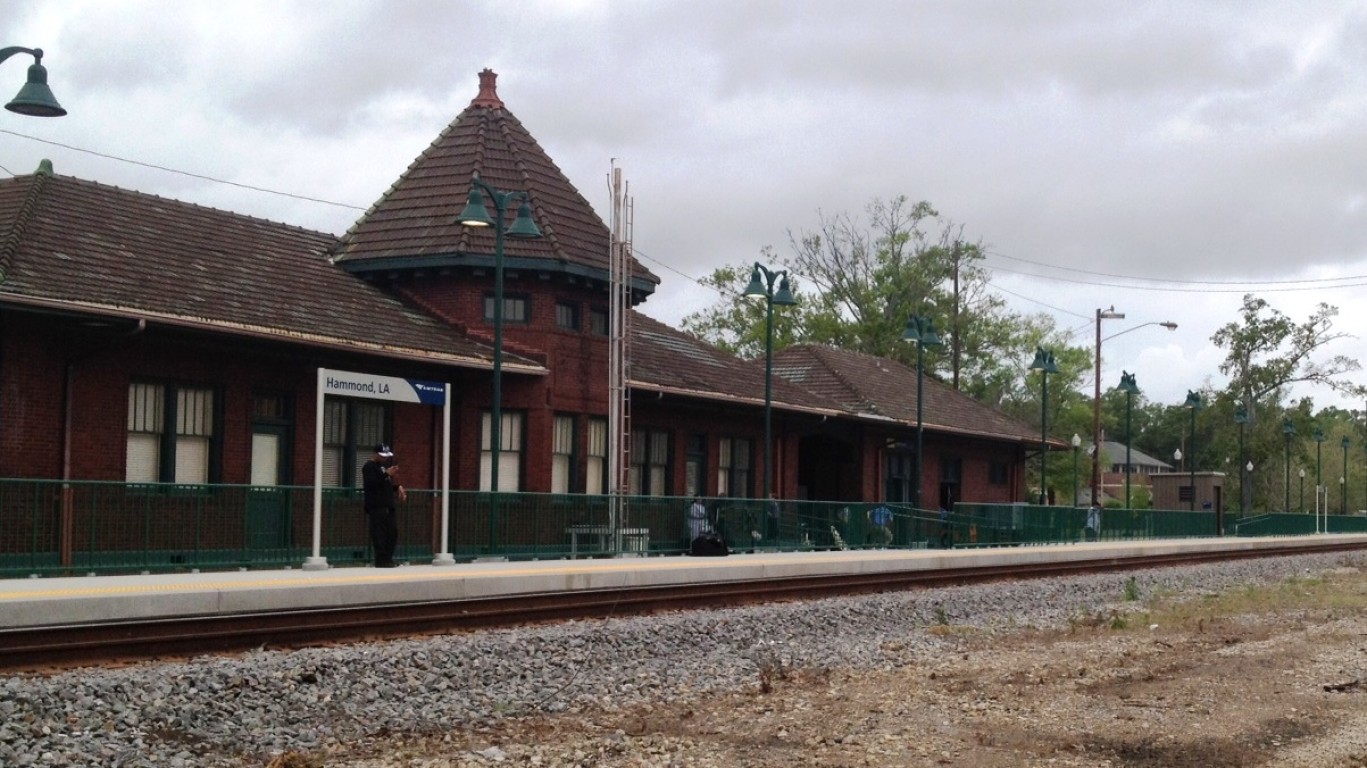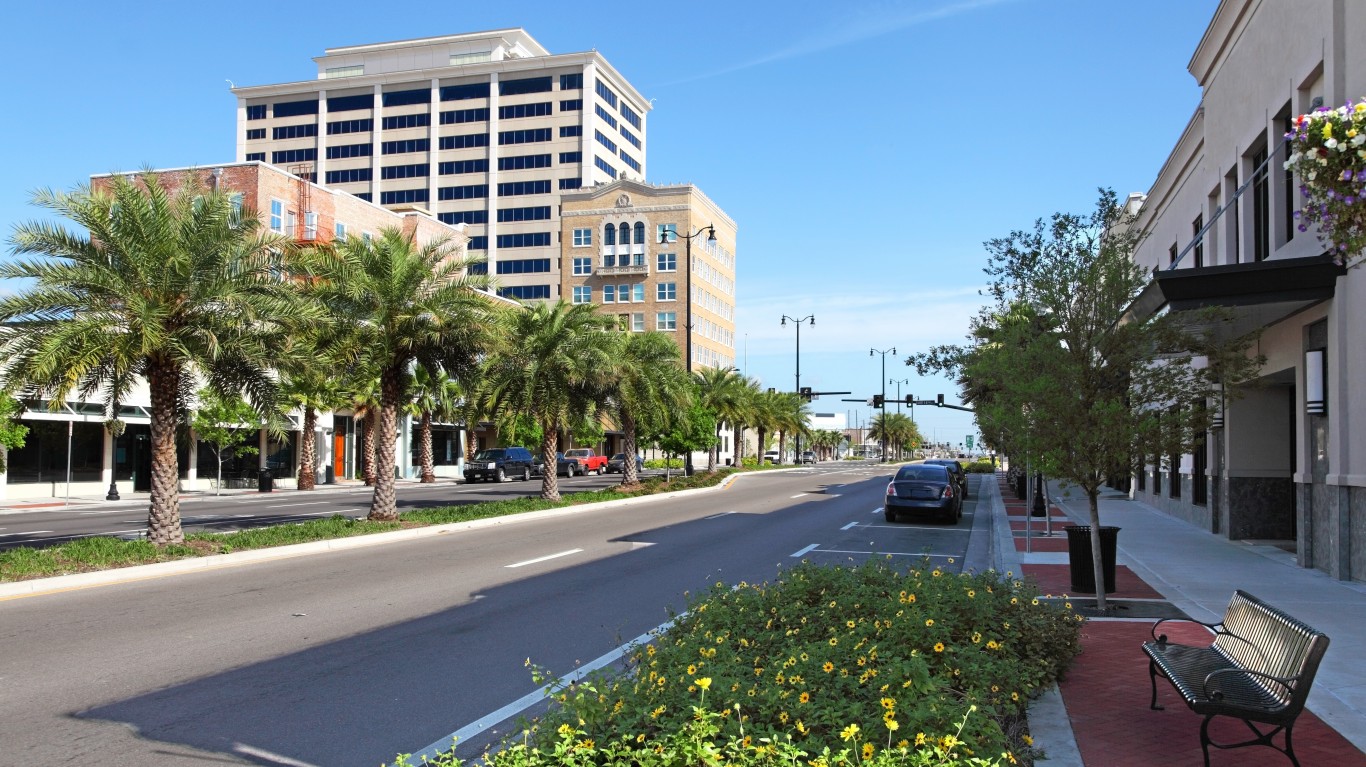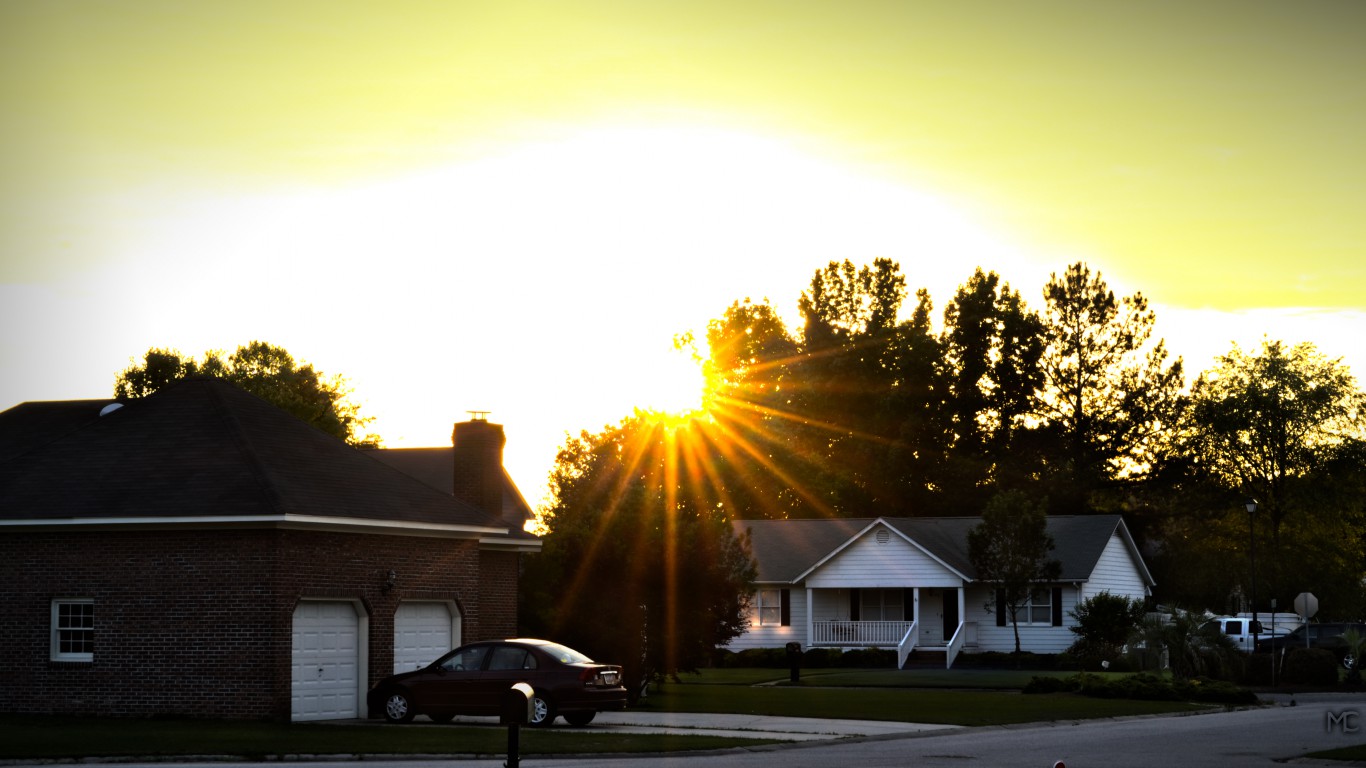
Life expectancy is one of the most telling and often cited measures of the health of a given population — and in the United States, life expectancy is falling at a historic rate. After declining for three consecutive years, life expectancy at birth in the United States stands at 78.6 years. The last time life expectancy fell three years in a row in the U.S. was over a century ago, when the country was fighting in World War I and was stricken by the Spanish Flu epidemic.
In a recent report, the Centers for Disease Control and Prevention identified several factors contributing to the decrease in life expectancy. These include climbing rates of several diseases and conditions like stroke, diabetes, and chronic liver disease, as well as unintentional injuries, which notably include drug overdoses. These conditions are often connected to unhealthy lifestyles — and in some parts of the country, both unhealthy behaviors and poor health outcomes are more common than in others.
24/7 Wall St. created a weighted index of 35 measures of health outcomes and health factors, including behaviors and access to care, and ranked 382 metropolitan areas based on the index to identify the least healthy metropolitan area in every state. Index measures include smoking rates, adult obesity rates, premature death rates, shares of adults who exercise regularly, and health insurance coverage.
It is important to note that appearing on this list does not necessarily mean a particular metro area is unhealthy compared to the United States as a whole. Many states have relatively healthy populations and average life expectancies that exceed the national average by several years. Even in the least healthy cities in some of these states, adults are more likely to live long, healthy lives than the typical American. These are the states where people live the longest.
Even though the cities on this list span the country, they tend to share certain socio-economic characteristics. For example, in the vast majority of the 50 metro areas on this list, the median annual household income is lower than the median income across the state as a whole. This is likely no coincidence, as lower-income Americans tend to have less access to health care options and can afford fewer healthy options related to diet and lifestyle, and therefore often report worse health outcomes.
Serious financial hardship can cause a great deal of stress and have other intangible negative effects on health. In many of the cities on this list, poverty is far more common than it is nationwide. Here is a full list of the cities hit hardest by extreme poverty in each state.
Click here to see the least healthy city in every state
Click here to see the healthiest city in every state
Click here to read our methodology

1. Alabama: Gadsden
> Premature death rate (per 100,000): 563.3 (state: 471.6)
> Adult obesity rate: 36.1% (state: 35.1%)
> Adult smoking rate: 23.1% (state: 21.5%)
> Median household income: $41,576 (state: $48,123)
Unhealthy lifestyles are relatively common in Gadsden, Alabama. Adults in the metro area are more likely to smoke and more likely to be obese than adults across the state as a whole. They are also less likely to exercise. More than one in every three adults in the metro area have sedentary lifestyles, compared to 28.2% of adults across the state and 22.0% of American adults nationwide.
Unhealthy habits may be taking a toll. The age-adjusted premature death rate of 563.3 deaths before age 75 for every 100,000 people annually is well above the premature death rate statewide of 472 per 100,000, and is the third highest rate of any metro area.
See all stories featuring: Alabama
[in-text-ad]

2. Alaska: Anchorage
> Premature death rate (per 100,000): 354.3 (state: 361.4)
> Adult obesity rate: 29.7% (state: 30.4%)
> Adult smoking rate: 15.9% (state: 19.0%)
> Median household income: $76,871 (state: $73,181)
Of the two metro areas in Alaska — Anchorage and Fairbanks — Anchorage ranks as the least healthy. Adults in Anchorage are less likely to exercise regularly and slightly more likely to be obese than those living in Fairbanks. Also, unlike in Fairbanks, adults in Anchorage report an average of over three mentally unhealthy days per month.
Those who are unemployed are more likely to have unhealthy behaviors such as high alcohol and tobacco consumption and poor diet, and report worse health outcomes than those who are employed. In Anchorage, the unemployment rate stands at 6.0%, higher than the 5.8% rate in Fairbanks.
See all stories featuring: Alaska

3. Arizona: Lake Havasu City-Kingman
> Premature death rate (per 100,000): 508.8 (state: 331.2)
> Adult obesity rate: 31.9% (state: 27.2%)
> Adult smoking rate: 20.0% (state: 14.7%)
> Median household income: $42,311 (state: $56,581)
Lake Havasu City has the highest premature death rate of any of the seven metro areas in Arizona. There are 509 deaths before age 75 annually for every 100,000 people in the metro area, more than double the statewide rate of 331 per 100,000.
Such severe negative health outcomes are likely partially attributable to unhealthy lifestyles in the metro area. For example, 20.0% of adults in Lake Havasu City smoke, compared to just 14.7% of adults statewide. Additionally, 31.9% of area adults are obese, compared to 27.2% of adults across the state. Obesity is a risk factor for a number of potentially fatal diseases and conditions, including heart disease, diabetes, and certain cancers.
See all stories featuring: Arizona

4. Arkansas: Pine Bluff
> Premature death rate (per 100,000): 561.3 (state: 462.1)
> Adult obesity rate: 40.1% (state: 35.2%)
> Adult smoking rate: 22.1% (state: 23.6%)
> Median household income: $39,914 (state: $45,869)
Pine Bluff is the least healthy metro area in Arkansas and one of the least healthy nationwide. Of the 382 metro areas in the United States, Pine Bluff is one of only two where over 40% of adults are obese. Obesity is a risk factor for a number of potentially deadly diseases and conditions, including diabetes, heart disease, and certain cancers, and premature death is far more common in Pine Bluff than it is across the state as a whole. For every 100,000 people in the metro area, there are 561 deaths before age 75 annually, compared to a rate of 462 deaths per 100,000 people across Arkansas.
Lower-income Americans have less access to quality health care options than those with higher incomes, and are less able to afford many of the components of a healthy lifestyle. In Pine Bluff, the typical household earns just $39,914 a year, compared to the median income of $45,869 statewide and $60,336 nationwide.
See all stories featuring: Arkansas
[in-text-ad-2]

5. California: Bakersfield
> Premature death rate (per 100,000): 398.6 (state: 272.3)
> Adult obesity rate: 30.6% (state: 22.7%)
> Adult smoking rate: 16.2% (state: 11.0%)
> Median household income: $49,854 (state: $71,805)
Of the 26 metro areas in California, Bakersfield is the least healthy. Smoking is the leading cause of preventable death in the United States, and in Bakersfield, 16.2% of adults are smokers, the largest share of any metro area in the state and higher than the statewide smoking rate of 11.0%. Bakersfield residents are also far less likely to exercise than the typical Californian. Just 77.0% of metro area adults engage in some leisure-time physical activity, compared to 82.6% of adults across the state.
The prevalence of sedentary lifestyles in Bakersfield may be due in part to a lack of exercise opportunities. Less than 80% of metro area residents have access to places for exercise like parks or recreation centers, compared to over 90% of all Californians.
See all stories featuring: California

6. Colorado: Pueblo
> Premature death rate (per 100,000): 430.3 (state: 285.2)
> Adult obesity rate: 28.0% (state: 21.0%)
> Adult smoking rate: 17.1% (state: 15.6%)
> Median household income: $43,148 (state: $69,117)
Pueblo is the only metro area in Colorado where adults report an average of more than four days of poor mental health in a month and more than four physically unhealthy days per month. Additionally, 22.1% of adults in the metro area report being in fair or poor health, by far the largest share in the state and one of the largest shares of any U.S. metro area. For context, 16.0% of American adults and 14.3% of adults in Colorado report being in fair or poor health.
Low-income Americans tend to have less access to quality health care options than those with higher incomes, and are less able to afford leading a healthy lifestyle. In Pueblo, the typical household earns just $43,148 a year. Meanwhile, the typical Colorado household earns nearly $70,000 annually.
See all stories featuring: Colorado
[in-text-ad]

7. Connecticut: New Haven-Milford
> Premature death rate (per 100,000): 302.7 (state: 273.8)
> Adult obesity rate: 27.1% (state: 25.5%)
> Adult smoking rate: 13.6% (state: 13.3%)
> Median household income: $66,863 (state: $74,168)
Adults in New Haven are more likely to report being in poor mental and physical health than those in any other metro area in Connecticut. Regular exercise can improve overall well-being, and in New Haven adults are less likely to be physically active than the average adult in the state.
Smoking is the leading cause of preventable death in the United States, and New Haven’s smoking rate of 13.6% is the highest of any metro area in the state. It is, however, still lower than the 17.0% national smoking rate.
See all stories featuring: Connecticut

8. Delaware: Dover
> Premature death rate (per 100,000): 393.0 (state: 357.3)
> Adult obesity rate: 33.8% (state: 30.6%)
> Adult smoking rate: 18.2% (state: 17.7%)
> Median household income: $57,608 (state: $62,852)
Dover is the only metro area in Delaware and ranks as the least healthy city by default. By several important measures, however, the capital city is less healthy than the state as a whole. For example, only 70.5% of metro area adults exercise regularly, compared to 74.6% of adults across the state. Regular physical activity can help in maintaining a healthy weight, and in Dover, 33.8% of adults are obese, a larger share than the 30.6% share of adults across the state.
See all stories featuring: Delaware

9. Florida: Ocala
> Premature death rate (per 100,000): 448.2 (state: 340.9)
> Adult obesity rate: 29.9% (state: 26.5%)
> Adult smoking rate: 17.8% (state: 15.5%)
> Median household income: $43,910 (state: $52,594)
The Ocala metro area ranks as the least healthy metro area in Florida and one of the least healthy nationwide. Just 68.9% of adults in Ocala exercise regularly, compared to 75.3% of adults statewide and 77.8% nationwide. Physical inactivity increases the risk of obesity compared to those who exercise regularly, and in Ocala 29.9% of adults are obese, more than the statewide rate of 26.5% and the nationwide rate of 28.5%.
Obesity is one of the leading causes of premature death. In Ocala, 448 in every 100,000 residents die before the age of 75, far more than the statewide premature death rate of 341 per 100,00 and the national rate of 340 per 100,000.
See all stories featuring: Florida
[in-text-ad-2]
10. Georgia: Albany
> Premature death rate (per 100,000): 505.0 (state: 380.5)
> Adult obesity rate: 33.5% (state: 30.3%)
> Adult smoking rate: 20.5% (state: 17.9%)
> Median household income: $43,614 (state: $56,183)
Smoking is the leading cause of preventable death in the United States, and in Albany, Georgia, 20.5% of adults are smokers, the largest share of any of the state’s 14 metro areas. Unhealthy habits like smoking likely contribute to Albany’s higher than average premature death rate. There are 505 deaths before age 75 for every 100,000 Albany residents annually, well above the state rate of 380 per 100,000.
Lower-income Americans have less access to quality health care than those with higher incomes, and often report worse health outcomes as a result. In Albany, the typical household earns just $43,614 a year, well below the median income of $56,183 across the state.
See all stories featuring: Georgia

11. Hawaii: Kahului-Wailuku-Lahaina
> Premature death rate (per 100,000): 266.7 (state: 278.6)
> Adult obesity rate: 23.2% (state: 23.1%)
> Adult smoking rate: 13.3% (state: 13.1%)
> Median household income: $80,183 (state: $77,765)
Of the two metro areas in Hawaii — Kahului-Wailuku-Lahaina and Honolulu — Kahului-Wailuku-Lahaina ranks as the least healthy. Residents of the Kahului metro area are slightly more likely to smoke and be obese than the average Hawaiian.
Still, the city is relatively healthy by some measures of self-reported health status. For example, adults in the area report an average of 3.1 physically unhealthy days per month, lower than the average of 3.4 days across Hawaii. Similarly, only 12.8% of adults in the metro area report to be in fair or poor health, below the 14.0% share across the state.
See all stories featuring: Hawaii
[in-text-ad]

12. Idaho: Pocatello
> Premature death rate (per 100,000): 386.3 (state: 307.4)
> Adult obesity rate: 30.8% (state: 28.3%)
> Adult smoking rate: 15.9% (state: 14.5%)
> Median household income: $51,612 (state: $52,225)
Adults in Pocatello are more likely to smoke and more likely to be obese than those across Idaho as a whole. Both smoking and obesity are risk factors for a number of potentially deadly diseases and conditions, and in Pocatello, the premature death rate of 386 deaths before age 75 is well above the state rate of 307 deaths per 100,000 people.
Self-reported health outcomes are also poor in Pocatello. Of the five metro areas in the state, Pocatello is the only one where adults report an average more than four physically unhealthy days per month.
See all stories featuring: Idaho

13. Illinois: Danville
> Premature death rate (per 100,000): 496.7 (state: 326.4)
> Adult obesity rate: 35.3% (state: 28.7%)
> Adult smoking rate: 18.0% (state: 15.8%)
> Median household income: $42,345 (state: $62,992)
Danville is the least healthy metro area in Illinois and among the least healthy in the entire country. Some 18.0% of metro area adults smoke, compared to 15.8% of adults across the state and 17.0% of adults nationwide. Smoking is the leading cause of preventable death in the United States, and in Danville, the premature death rate of 497 deaths before age 75 annually for every 100,000 people is nearly double the state rate of 326 per 100,000.
Living in poverty can greatly reduce a person’s ability to make healthy lifestyle choices, and as a result, poorer Americans often report worse health outcomes. In Danville, 19.9% of residents live below the poverty line, compared to 12.6% of the Illinois population.
See all stories featuring: Illinois

14. Indiana: Kokomo
> Premature death rate (per 100,000): 507.8 (state: 398.3)
> Adult obesity rate: 32.9% (state: 32.8%)
> Adult smoking rate: 24.0% (state: 21.1%)
> Median household income: $49,346 (state: $54,181)
Kokomo has the highest premature death rate of any of the 12 metro areas in Indiana. For every 100,000 Kokomo residents, there are 508 deaths before age 75 annually, compared to the statewide premature death rate of 399 per 100,000. Smoking is the leading cause of premature death in the United States, and in Kokomo 24.0% of adults are smokers, compared to the statewide smoking rate of 21.1%.
See all stories featuring: Indiana
[in-text-ad-2]

15. Iowa: Davenport-Moline-Rock Island
> Premature death rate (per 100,000): 342.9 (state: 315.5)
> Adult obesity rate: 31.1% (state: 32.2%)
> Adult smoking rate: 16.3% (state: 16.7%)
> Median household income: $54,173 (state: $58,570)
Though Davenport ranks as the least healthy metro area in Iowa, area adults still tend to he healthier than the typical American by several health measures. For example, 14.1% of adults in the metro area report being in fair or poor health. While this is a larger share than the 13.1% of adults across the state reporting similarly low health status, it is lower than the nationwide figure of 16.0% of adults. Additionally, Davenport’s 16.3% smoking rate and 31.1% obesity rate are closely in line with the comparable state and national rates.
See all stories featuring: Iowa

16. Kansas: Wichita
> Premature death rate (per 100,000): 392.6 (state: 348.7)
> Adult obesity rate: 33.9% (state: 33.2%)
> Adult smoking rate: 18.5% (state: 17.2%)
> Median household income: $54,432 (state: $56,422)
Certain unhealthy habits are more common in Wichita than in any other metro area in the state. For example, 18.5% of adults smoke, and 24.5% of adults do not exercise regularly, each the largest share of the four metro areas in Kansas. Unhealthy lifestyles appear to be taking a toll, as adults in Wichita are more likely than those in other Kansas metro areas to assess their own health as fair or poor.
Unemployment is associated with unhealthy behaviors such as tobacco and alcohol consumption and poor diet, and an increased risk of premature mortality overall. In Wichita, the unemployment rate stands at 3.7%, higher than every other metro area in Kansas and higher than the statewide jobless rate of 3.4%.
See all stories featuring: Kansas
[in-text-ad]

17. Kentucky: Bowling Green
> Premature death rate (per 100,000): 436.3 (state: 471.7)
> Adult obesity rate: 32.1% (state: 34.2%)
> Adult smoking rate: 20.2% (state: 24.5%)
> Median household income: $46,478 (state: $48,375)
People living in urban areas tend to have healthier behaviors and better health outcomes than those living in rural areas. So while Bowling Green is the least healthy city in Kentucky, it is still healthier than the population of the relatively rural state as a whole by several measures.
Some 20.2% of Bowling Green residents smoke, less than the smoking rate of 24.5% statewide. Additionally, 32.1% of Bowling Green adults are obese, compared to the state obesity rate of 34.2%. Overall, 436 in every 100,000 Bowling Green residents die before the age of 75, the second highest premature death rate of any metro area in Kentucky yet less than the state rate of 472 per 100,000.
See all stories featuring: Kentucky

18. Louisiana: Hammond
> Premature death rate (per 100,000): 500.7 (state: 452.5)
> Adult obesity rate: 38.5% (state: 35.3%)
> Adult smoking rate: 20.4% (state: 22.8%)
> Median household income: $44,861 (state: $46,145)
Monroe is the least healthy of the nine metro areas in Louisiana. Smoking is the leading cause of preventable death in the United States. And though the smoking rate of 22.5% in Monroe is lower than the 22.8% rate for Louisiana as a whole, it is higher than in every other metro area in the state.
Monroe residents are also more likely to report low health status than the average Louisianian. Adults in Monroe report 4.4 mentally unhealthy days and 4.2 physically unhealthy days per month on average, the most of any metro area in the state.
See all stories featuring: Louisiana

19. Maine: Bangor
> Premature death rate (per 100,000): 374.6 (state: 337.8)
> Adult obesity rate: 31.9% (state: 29.4%)
> Adult smoking rate: 19.0% (state: 19.8%)
> Median household income: $50,349 (state: $56,277)
Adults in the Bangor metro area are slightly less likely to regularly engage in physical activity than adults across Maine as a whole. Regular exercise can help in maintaining a healthy weight, and in Bangor 31.9% of adults are obese, compared to 29.4% of adults across the state. Exercise and other healthy behaviors can also help lower the risk of premature death. In Bangor, some 375 in every 100,000 residents die before the age of 75, more than the statewide rate of 338 per 100,000.
Living in poverty can greatly reduce a person’s opportunities to live a healthy lifestyle, and as a result, poorer Americans often report worse health outcomes. In Bangor, 14.6% of residents live below the poverty line, compared to 11.1% of the Maine population.
See all stories featuring: Maine
[in-text-ad-2]

20. Maryland: Cumberland
> Premature death rate (per 100,000): 428.6 (state: 335.8)
> Adult obesity rate: 37.1% (state: 30.3%)
> Adult smoking rate: 17.4% (state: 13.7%)
> Median household income: $42,113 (state: $80,776)
Cumberland is the least healthy of the five metro areas in Maryland. The smoking rate in the city is 17.4%, higher than both the state smoking rate of 13.7% and the national rate of 17.0%. Smoking is one of the leading causes of preventable death in the United States, and in Cumberland, there are 428 premature deaths annually for every 100,000 people, well above the state rate of 336 per 100,000.
Lower-income Americans do not have access to as many health care options as those with higher incomes, and they are less able to afford leading a healthy lifestyle. In Cumberland, the typical household earns just $42,113 a year. Meanwhile, the typical Maryland household earns over $80,000 annually.
See all stories featuring: Maryland

21. Massachusetts: Springfield
> Premature death rate (per 100,000): 324.2 (state: 284.7)
> Adult obesity rate: 26.3% (state: 24.4%)
> Adult smoking rate: 17.1% (state: 13.6%)
> Median household income: $55,379 (state: $77,385)
Springfield is the least healthy of the five metro areas in Massachusetts. Some 16.4% of metro area adults in the city report being in fair or poor health, a larger share than every other metro area in the state and well above the 13.8% share of adults across Massachusetts as a whole.
The prevalence of low self-reported health status in Springfield is likely attributable in part to unhealthy lifestyles. Adults in Springfield more likely to lead sedentary lives and more likely to smoke than adults in every other metro area in the state.
See all stories featuring: Massachusetts
[in-text-ad]

22. Michigan: Flint
> Premature death rate (per 100,000): 466.7 (state: 366.4)
> Adult obesity rate: 32.4% (state: 31.7%)
> Adult smoking rate: 20.8% (state: 20.4%)
> Median household income: $46,298 (state: $54,909)
Low birthweight can be indicative of unhealthy maternal lifestyles, limited access to health care, and other negative environmental factors. Flint is the only metro area in Michigan where over 10% of newborns weigh under what is considered a healthy weight, the largest share in the state. Flint also has the highest premature death rate among metro areas in the state, with 467 deaths before age 75 annually for every 100,000 people.
Those who are unemployed are more likely to have unhealthy behaviors and report worse health outcomes than those who are employed. In Flint, the unemployment rate stands at 4.9%, the highest of any metro area in the state.
See all stories featuring: Michigan

23. Minnesota: Duluth
> Premature death rate (per 100,000): 336.6 (state: 266.5)
> Adult obesity rate: 29.8% (state: 27.6%)
> Adult smoking rate: 17.6% (state: 15.2%)
> Median household income: $54,162 (state: $68,388)
Smoking — the leading cause of preventable death in the United States — is relatively common in Duluth, as 17.6% of adults are smokers, the highest smoking rate of any other metro area in Minnesota. Adults in Duluth are also less likely to exercise regularly than adults in any other metro area in the state. Regular physical activity can help in maintaining a healthy weight, and in Duluth, 29.8% of adults are obese, a larger share than the 27.6% state obesity rate.
Living in poverty can greatly reduce an individual’s ability to make healthy lifestyle choices, and as a result, poorer Americans often report worse health outcomes. In Duluth, 13.6% of residents live below the poverty line compared to 9.5% of the Minnesota population.
See all stories featuring: Minnesota

24. Mississippi: Gulfport-Biloxi-Pascagoula
> Premature death rate (per 100,000): 469.1 (state: 499.1)
> Adult obesity rate: 34.0% (state: 36.5%)
> Adult smoking rate: 20.1% (state: 22.7%)
> Median household income: $47,099 (state: $43,529)
Though Gulfport-Biloxi-Pascagoula ranks as the least healthy metro area in Mississippi, by several measures, area residents are more likely to be healthy than those living in rural parts of the state. For example, adults in the metro area report an average of 4.0 physically unhealthy days per month, the most of any metro area in Mississippi but below the 4.4-day average for the state as a whole.
The same is true for some unhealthy habits. Though the 20.1% smoking rate in Gulfport is the highest of any metro area in the state, it is below the 22.7% statewide smoking rate.
See all stories featuring: Mississippi
[in-text-ad-2]

25. Missouri: St. Joseph
> Premature death rate (per 100,000): 414.4 (state: 395.9)
> Adult obesity rate: 35.7% (state: 32.2%)
> Adult smoking rate: 23.1% (state: 22.1%)
> Median household income: $47,309 (state: $53,578)
Some 35.7% of adults in the St. Joseph metro area are obese, the largest share of any metro area in Missouri. Additionally, 23.1% of adults smoke, also the largest share in the state. Unhealthy lifestyles can contribute to poor health outcomes, and more than one in every five adults in St. Joseph report being in fair or poor health — the largest share of any metro area in Missouri and well above both the 18.5% state and 16.0% national rates.
Adults in St. Joseph are also less likely to exercise than the typical adult in the state. The prevalence of sedentary lifestyles may be partially attributable to a lack of exercise opportunities in the metro area. Just 72.4% of the metro population has access to places for physical activity like parks and recreation centers — below the 76.3% share of state residents and 84.0% of Americans nationwide.
See all stories featuring: Missouri

26. Montana: Great Falls
> Premature death rate (per 100,000): 389.6 (state: 346.6)
> Adult obesity rate: 26.5% (state: 25.4%)
> Adult smoking rate: 18.4% (state: 18.5%)
> Median household income: $47,713 (state: $53,386)
Of the three metro areas in Montana, Great Falls is the least healthy. Adults in Great Falls are the least likely to exercise and most likely to smoke of any metro area in the state.
Uninsured adults are less likely to receive preventative medical care than adults with health insurance, and they are more likely to suffer negative health consequences such as preventable hospitalization as a result. In Great Falls, 10.2% of adults under age 65 lack health insurance, the largest uninsured rate in Montana. Additionally, there are 3,688 preventable hospitalizations per 100,000 Medicare enrollees in Great Falls, the highest rate of any metro area in the state.
See all stories featuring: Montana
[in-text-ad]

27. Nebraska: Omaha-Council Bluffs
> Premature death rate (per 100,000): 321.8 (state: 307.4)
> Adult obesity rate: 31.0% (state: 31.2%)
> Adult smoking rate: 16.4% (state: 17.0%)
> Median household income: $65,619 (state: $59,970)
Smoking is the leading cause of preventable death in the United States. Though the smoking rate of 16.4% in Omaha-Council Bluffs is below the rate of 17.0% amongst adults across the state, it is higher than the smoking rate in the two other metro areas in Nebraska — Grand Island and Lincoln. The premature death rate in Omaha of 322 deaths before age 75 for every 100,000 people is also higher than the statewide rate of 307 deaths per 100,000 Nebraska residents.
Lower-income households cannot afford as many healthy options related to health care, diet, and lifestyle as wealthy households, and as a result they often report worse health outcomes. In Omaha, 5.3% of households live on less than $10,000 a year, the largest share of any Nebraska metro area and slightly higher than the statewide share of 5.2%.
See all stories featuring: Nebraska
28. Nevada: Carson City
> Premature death rate (per 100,000): 513.5 (state: 364.4)
> Adult obesity rate: 27.5% (state: 26.5%)
> Adult smoking rate: 17.7% (state: 16.5%)
> Median household income: $55,700 (state: $58,003)
Carson City has far and away the highest premature death rate of any metro area in Nevada. There are 514 deaths before age 75 for every 100,000 people in the metro area annually, more than double the state premature death rate of 364 per 100,000.
Smoking is the leading cause of preventable death in the United States. In Carson City, 17.7% of adults smoke, higher than the 16.5% state smoking rate. Obesity is also a risk factor for a number of potentially deadly diseases and conditions, including stroke, diabetes, and certain cancers, and Carson City’s 27.5% obesity rate is the highest of the three metro areas in Nevada.
See all stories featuring: Nevada

29. New Hampshire: Manchester-Nashua
> Premature death rate (per 100,000): 315.4 (state: 307.6)
> Adult obesity rate: 28.2% (state: 28.0%)
> Adult smoking rate: 15.2% (state: 18.0%)
> Median household income: $78,769 (state: $73,381)
Manchester is the only metro area in New Hampshire and therefore ranks as the least healthy city by default. Still, Manchester is slightly worse off than the state as a whole in a number of health outcomes. For example, Manchester’s premature death rate of 315 deaths before age 75 per 100,000 people is above the comparable state rate of 308 per 100,000.
Despite the poorer health outcomes, Manchester residents are more likely to exhibit certain healthy habits than the typical New Hampshire resident. Just 15.2% of metro area adults smoke, and 19.7% drink excessively, compared to 18.0% and 20.1% of adults statewide, respectively.
See all stories featuring: New Hampshire
[in-text-ad-2]

30. New Jersey: Vineland-Bridgeton
> Premature death rate (per 100,000): 452.3 (state: 288.1)
> Adult obesity rate: 35.1% (state: 26.2%)
> Adult smoking rate: 17.2% (state: 14.0%)
> Median household income: $52,627 (state: $80,088)
In Vineland-Bridgeton, 23.2% of adults report being in fair or poor health, by far the largest share of any of the state’s four metro areas and well above the 16.5% share of adults who report similar health outcomes across New Jersey as a whole.
Poor health status among area adults may be partially attributable to unhealthy lifestyles. Just 69.8% of adults in the Vineland metro exercise regularly, the largest share in New Jersey. Adults in Vineland are also more likely to smoke and be obese than than the average adult in the state.
See all stories featuring: New Jersey

31. New Mexico: Farmington
> Premature death rate (per 100,000): 456.5 (state: 392.8)
> Adult obesity rate: 32.8% (state: 25.6%)
> Adult smoking rate: 18.5% (state: 16.6%)
> Median household income: $45,942 (state: $46,744)
Farmington is the only metro area in New Mexico where adults report an average of over four mentally unhealthy days per month. With an obesity rate of 32.8%, the metro area also has far and away the largest share of adults who are dangerously overweight.
Such unhealthy outcomes are likely due in part to the prevalence of unhealthy lifestyles. Regular exercise can be good for mental health and help in maintaining a healthy weight. In Farmington, 22.5% of adults get no exercise beyond getting up and going to work, by far the largest share of any metro area in the state and well above the 18.2% of adults across the state who lead sedentary lives.
See all stories featuring: New Mexico
[in-text-ad]

32. New York: Elmira
> Premature death rate (per 100,000): 390.5 (state: 279.4)
> Adult obesity rate: 34.6% (state: 25.7%)
> Adult smoking rate: 20.6% (state: 14.2%)
> Median household income: $51,194 (state: $64,894)
Elmira is the only one of New York’s 12 metro areas where adults report an average of over four physically unhealthy days per month. It is also the only metro area in the state where more than one in every five adults smoke and more than one in every three adults are obese.
Low-income Americans have less access to quality health care options than those with higher incomes, and are less able to afford the components of a healthy lifestyle. In Elmira, the typical household earns just $51,194 a year, compared to the statewide median of $64,894.
See all stories featuring: New York

33. North Carolina: Rocky Mount
> Premature death rate (per 100,000): 487.3 (state: 372.2)
> Adult obesity rate: 36.7% (state: 30.2%)
> Adult smoking rate: 19.6% (state: 17.9%)
> Median household income: $42,784 (state: $52,752)
Rocky Mount’s premature death rate of 487 deaths before age 75 for every 100,000 people is by far the highest of any of the 15 metro areas in North Carolina. It is also far higher than the state premature death rate of 372 per 100,000.
The higher premature death rate in the metro area is likely due in part to the prevalence of some unhealthy behaviors and outcomes. For example, 36.7% of metro area adults are obese, the largest share of any metro area in the state. Obesity is a risk factor for a number of potentially deadly diseases and conditions, including diabetes, heart disease, and certain cancers.
See all stories featuring: North Carolina

34. North Dakota: Bismarck
> Premature death rate (per 100,000): 366.4 (state: 318.8)
> Adult obesity rate: 31.0% (state: 32.2%)
> Adult smoking rate: 16.7% (state: 19.8%)
> Median household income: $66,087 (state: $61,843)
People living in urban areas tend to have healthier behaviors and better health outcomes than residents of rural areas. So while Bismarck ranks as the least healthy metro area in North Dakota, it performs better than the state as a whole in several measures.
For example, 16.7% of adults in Bismarck smoke, less than the 19.8% state smoking rate. Similarly, 31.0% of Bismarck adults are obese, slightly less than the 32.2% state obesity rate. Adults who do not smoke and are normal weight are less likely to self-report being in poor health, and in Bismarck, 12.4% of adults report being in fair or poor health, less than the 14.3% of adults who do statewide and the 16.0% who do nationwide.
See all stories featuring: North Dakota
[in-text-ad-2]

35. Ohio: Springfield
> Premature death rate (per 100,000): 533.7 (state: 403.9)
> Adult obesity rate: 35.7% (state: 31.8%)
> Adult smoking rate: 22.0% (state: 22.5%)
> Median household income: $46,665 (state: $54,021)
Springfield is the only metro are in Ohio where adults report an average of over four physically unhealthy days per month. Springfield residents are also more likely than those in any other Ohio metro area to die prematurely. There are 534 deaths before age 75 for every 100,000 metro area residents annually, compared to the statewide premature death rate of 404 per 100,000.
Poor health outcomes are partially attributable to unhealthy lifestyles. For example, adults in Springfield are less likely to exercise than adults across the state, and Springfield’s 35.7% obesity rate is the highest of the 11 metro areas in Ohio.
See all stories featuring: Ohio

36. Oklahoma: Lawton
> Premature death rate (per 100,000): 469.0 (state: 458.3)
> Adult obesity rate: 32.8% (state: 33.3%)
> Adult smoking rate: 20.5% (state: 19.6%)
> Median household income: $50,702 (state: $50,051)
Some 16.2% of residents in the Lawton metro area live below the poverty line, the highest poverty rate of any city in Oklahoma and higher than the rate of 15.8% statewide. Income is one of the largest determinants of health, and areas with higher poverty rates tend to have worse health behaviors and outcomes.
In Lawton, 20.5% of adults smoke, the highest smoking rate of any Oklahoma metro area. Just 70.2% of adults regularly exercise, less than the 71.6% state activity rate and one of the smallest shares nationwide. Tobacco use and inactivity are two of the leading causes of premature death, and in Lawton, 469 in every 100,000 residents die before the age of 75 — the highest premature death rate in Oklahoma and among the highest of any city in the country.
See all stories featuring: Oklahoma
[in-text-ad]

37. Oregon: Grants Pass
> Premature death rate (per 100,000): 426.9 (state: 309.0)
> Adult obesity rate: 29.5% (state: 28.3%)
> Adult smoking rate: 18.3% (state: 16.2%)
> Median household income: $44,426 (state: $60,212)
In Grants Pass, 17.1% of adults are in fair or poor health, the largest share of any metro area in the state. Adults in Grants Pass are also more likely to report being in poor mental or physical health than the average Oregon resident statewide.
Low-income households cannot afford as many healthy options related to diet and lifestyle as wealthier households, and often report worse health outcomes as a result. In Grants Pass, the typical household earns just $44,426 a year, well below the $60,212 state median.
See all stories featuring: Oregon

38. Pennsylvania: Johnstown
> Premature death rate (per 100,000): 462.5 (state: 359.2)
> Adult obesity rate: 29.3% (state: 29.9%)
> Adult smoking rate: 17.3% (state: 18.0%)
> Median household income: $46,598 (state: $59,195)
Johnstown is the only metro area in Pennsylvania where adults report an average of more than four physically unhealthy days per month. Johnstown also has the highest premature death rate of any of the 18 metro areas in Pennsylvania. There are 463 deaths before age 75 annually for every 100,000 metro area residents, well above the state premature death rate of 359 per 100,000.
Pennsylvania has been hit particularly hard by the opioid epidemic, and Johnstown is one of the hardest hit metro areas in the state. For every 100,000 Johnstown residents, there are 120 deaths from unintentional injury — the leading cause of which is drug overdose — far more than the state rate of 81 injury deaths per 100,000 Pennsylvania residents and the national rate of 67 injury deaths per 100,000 Americans.
See all stories featuring: Pennsylvania

39. Rhode Island: Providence-Warwick
> Premature death rate (per 100,000): 322.8 (state: 307.3)
> Adult obesity rate: 27.6% (state: 27.0%)
> Adult smoking rate: 16.2% (state: 14.4%)
> Median household income: $65,226 (state: $63,870)
The Providence-Warwick metro area encompasses all five counties in Rhode Island as well as Bristol County in Massachusetts. As the only metro area in Rhode Island, Providence ranks as the least healthy city in the state by default, and matches the state as a whole in most measures of health behaviors and outcomes. For example, 27.6% of adults in Providence are obese, compared to 27.0% of adults across the state. Similarly, 14.5% of adults in Providence report being in fair or poor health, closely in line with the 14.8% of adults who do throughout Rhode Island.
See all stories featuring: Rhode Island
[in-text-ad-2]

40. South Carolina: Florence
> Premature death rate (per 100,000): 518.4 (state: 414.2)
> Adult obesity rate: 36.6% (state: 32.4%)
> Adult smoking rate: 19.8% (state: 20.0%)
> Median household income: $40,562 (state: $50,570)
Only about 70% of adults in the Florence metro area get regular exercise, a smaller share than the 75% of adults across South Carolina who do. Remaining active can help in maintaining a healthy weight, and in Florence, 36.6% of adults are obese, compared to 32.4% of adults statewide.
Obesity is a risk factor for a number of potentially deadly diseases and conditions, including diabetes, heart disease, and certain cancers, and is a leading cause of premature death overall. In Florence, there are 518 deaths before age 75 for every 100,000 people annually, well above the state premature death rate of 414 per 100,000.
See all stories featuring: South Carolina

41. South Dakota: Rapid City
> Premature death rate (per 100,000): 315.7 (state: 339.7)
> Adult obesity rate: 26.8% (state: 31.1%)
> Adult smoking rate: 15.5% (state: 18.1%)
> Median household income: $56,318 (state: $56,521)
Of the two metro areas in South Dakota — Sioux Falls and Rapid City — Rapid City is the least healthy. Unlike in Sioux Falls, adults in Rapid City report more than three physically unhealthy days and more than three mentally unhealthy days per month on average.
Some 12.6% of adults in Rapid City report being in fair or poor health, more than the 10.0% of adults who report similar health outcomes in Sioux Falls and the 11.8% of adults in fair or poor health statewide. For every 100,000 Rapid City residents, 316 die before the age of 75 — more than the Sioux Falls premature death rate of 302 per 100,000, yet less than the state rate of 340 per 100,000.
See all stories featuring: South Dakota
[in-text-ad]

42. Tennessee: Memphis
> Premature death rate (per 100,000): 468.2 (state: 445.6)
> Adult obesity rate: 35.1% (state: 33.0%)
> Adult smoking rate: 20.3% (state: 22.1%)
> Median household income: $50,984 (state: $51,340)
Low birthweight can be indicative of unhealthy maternal lifestyles, limited access to health care, and other negative environmental factors. In Memphis, 11.2% of newborns weigh less than what is considered a healthy weight, compared to 9.1% of newborns across the state as a whole.
Living below the poverty line can greatly reduce an individual’s ability to make healthy lifestyle choices, and as a result, poorer Americans often report worse health outcomes. In Memphis, 17.1% of residents live below the poverty line, compared to 15.0% of the Tennessee population.
See all stories featuring: Tennessee

43. Texas: Texarkana
> Premature death rate (per 100,000): 499.7 (state: 339.5)
> Adult obesity rate: 37.4% (state: 29.0%)
> Adult smoking rate: 19.3% (state: 14.3%)
> Median household income: $47,722 (state: $59,206)
In Texarkana, Texas, 37.4% of adults are obese, well above the state obesity rate of 29.0%. Obesity is a risk factor for a number of potentially deadly diseases and conditions, including diabetes, heart disease, and certain cancers, and premature death is far more common in Texarkana than it is across the state as a whole. For every 100,000 people in the metro area, there are 500 deaths before age 75 annually, compared to 339 per 100,000 across Texas.
See all stories featuring: Texas

44. Utah: Salt Lake City
> Premature death rate (per 100,000): 308.9 (state: 291.5)
> Adult obesity rate: 25.3% (state: 25.9%)
> Adult smoking rate: 9.5% (state: 8.8%)
> Median household income: $71,510 (state: $68,358)
Of Utah’s five metro areas, Salt Lake City is the least healthy. Part of the reason may be environmental. The air in Salt Lake City has the highest concentration of harmful particulate matter of any of any other metro area in the state. Still, Salt Lake City’s air is cleaner than average on a national scale.
Adults in Salt Lake City are also more likely than those in every other metro area in the state to have certain unhealthy habits. For example, 16.0% of adults in the city drink excessively and 9.5% smoke, higher than the excessive drinking rate of 13.4% and the smoking rate of 8.8% statewide.
See all stories featuring: Utah
[in-text-ad-2]

45. Vermont: Burlington-South Burlington
> Premature death rate (per 100,000): 283.6 (state: 300.0)
> Adult obesity rate: 22.6% (state: 25.5%)
> Adult smoking rate: 13.0% (state: 17.0%)
> Median household income: $63,160 (state: $57,513)
Burlington is the only metro area in Vermont, and as a result, it ranks as the least healthy city in the state by default only. In fact, in several measures, city residents are more likely to have healthier lifestyles and report better health outcomes than those living across the state as a whole. For example, just 13.0% of adults in Burlington smoke, compared to 17.0% of the adult population in Vermont as a whole. Adults in Burlington are also more likely to regularly exercise and are less likely to be obese than the typical adult in the state.
Healthy behaviors can lead to healthy outcomes, and in Burlington, adult residents report an average of just 3.6 mentally unhealthy days per month, compared to an average of about four days per month across the state.
See all stories featuring: Vermont

46. Virginia: Roanoke
> Premature death rate (per 100,000): 415.7 (state: 318.9)
> Adult obesity rate: 29.9% (state: 28.8%)
> Adult smoking rate: 16.5% (state: 15.3%)
> Median household income: $54,233 (state: $71,535)
Premature death — before age 75 — is more prevalent in Roanoke than in any other metro area in Virginia. There are 412 premature deaths for every 100,000 people annually in the metro area, compared to the state rate of 319 premature deaths per 100,000 Virginia residents.
Smoking is the leading cause of preventable death in the United States, and in Roanoke, 16.5% of adults are smokers, compared to 15.3% of adults across the state. Additionally, obesity is a risk factor for a number of potentially deadly diseases and conditions, including diabetes, heart disease, and certain cancers. In Roanoke, 29.9% of adults are obese, slightly higher than the 28.8% state obesity rate.
See all stories featuring: Virginia
[in-text-ad]
47. Washington: Yakima
> Premature death rate (per 100,000): 362.4 (state: 288.7)
> Adult obesity rate: 32.1% (state: 27.6%)
> Adult smoking rate: 15.2% (state: 13.9%)
> Median household income: $47,402 (state: $70,979)
In Yakima, Washington, 21.2% of adults report being in fair or poor health, by far the largest share of any metro area in the state and more than the 13.9% of adults across Washington who report similar health outcomes.
Living with serious financial hardship can reduce access to health care options as well as reduce the ability to make healthier lifestyle choices, and as a result, poorer Americans often report worse health outcomes. In Yakima, 18.1% of residents live below the poverty line, compared to the state poverty rate of 11.0%.
See all stories featuring: Washington

48. West Virginia: Beckley
> Premature death rate (per 100,000): 592.2 (state: 492.7)
> Adult obesity rate: 39.3% (state: 36.3%)
> Adult smoking rate: 24.3% (state: 24.8%)
> Median household income: $42,493 (state: $43,469)
Beckley, West Virginia, has the highest premature death rate in the United States. There are 592 deaths before age 75 annually for every 100,000 people, more than the state rate of 493 per 100,000 and the national rate of 340 per 100,000. Smoking is the leading cause of preventable death in the United States, and in Beckley, 24.3% of adults smoke, the largest share of any metro area in the state and well above the 17.0% national smoking rate.
Those who are unemployed are more likely to have unhealthy behaviors and to report worse health outcomes than those who are employed. In Beckley, the unemployment rate stands at 5.7%, higher than the 5.3% rate across the state.
See all stories featuring: West Virginia

49. Wisconsin: Milwaukee-Waukesha-West Allis
> Premature death rate (per 100,000): 355.4 (state: 308.5)
> Adult obesity rate: 31.1% (state: 31.1%)
> Adult smoking rate: 16.2% (state: 17.1%)
> Median household income: $59,448 (state: $59,305)
Education and income are two of the primary determinants of health. While some 35.8% of adults in Milwaukee have a bachelor’s degree and 5.7% of households in the metro area earn at least $200,000 a year — each the second largest share in Wisconsin — it still ranks as the least healthy city in the state.
Some 8.7% of births in Milwaukee are considered low birthweight, by far the largest share in Wisconsin and more than the 7.3% rate statewide. Low birthweight is often an indication of poor maternal health. Similarly, 355 in every 100,000 Milwaukee residents die before the age of 75, more than the state premature death rate of 309 per 100,000 and the highest rate of any city in the state.
See all stories featuring: Wisconsin
[in-text-ad-2]

50. Wyoming: Casper
> Premature death rate (per 100,000): 386.8 (state: 348.5)
> Adult obesity rate: 31.5% (state: 28.5%)
> Adult smoking rate: 16.9% (state: 18.9%)
> Median household income: $60,546 (state: $60,434)
In Casper, Wyoming, there are 387 deaths before age 75 for every 100,000 people annually, a higher premature death rate than in Cheyenne — the only other metro area in the state — and across Wyoming as a whole.
Obesity is a risk factor for a number of potentially deadly diseases and conditions, including diabetes, heart disease, and certain cancers. In Casper, 31.5% of adults are obese, higher than the 28.5% state obesity rate and the 30.5% obesity rate in Cheyenne.
See all stories featuring: Wyoming
Methodology
To determine the least healthy city in every state, 24/7 Wall St. created an index composed of 35 health outcomes and health factors with data from the 2019 County Health Rankings & Roadmaps, a joint program of the Robert Wood Johnson Foundation and the University of Wisconsin Population Health Institute. We calculated composite scores for outcomes and factors separately, then combined the two scores to form a single score that determines the metropolitan statistical area’s rank.
All data used in the index came from the CHR, with the exception of the MSA 2018 annual unemployment rate, the most recent annual figures available from the Bureau of Labor Statistics’ Local Area Unemployment Statistics program. County-level data was aggregated to the MSA level using 2017 five-year population estimates from the U.S. Census Bureau’s American Community Survey.
We also considered measures from the ACS including median household income, poverty, and educational attainment. These measures were not included in the index.
Values selected for the index are standardized into Z-Scores, which assumes a mean of 0 and a standard deviation of 1. Z-scores are calculated for each index measure by MSA within each city’s respective state. If an MSA spans multiple states, then the city is indexed according to its primary state, as designated by the Census Bureau. Note that four states — Rhode Island, New Hampshire, Vermont, and Delaware — only have one MSA.
Health outcomes with the heaviest weights in the index include the age-adjusted premature mortality rate, the percentage of births with low birthweight, the percentage of adults reporting fair or poor health, and the age-adjusted average number of mentally and physically unhealthy days per month. The premature mortality rate is defined as the number of deaths under the age of 75 per 100,000 people. Unhealthy days are determined by the average number of days out of the month the adult population (18+) self-identifies as being unwell. This is used as an indicator of how chronic disabilities or illnesses (physical and mental) affect the members of a particular geography.
Health factors with the heaviest weights in the index include the smoking rate, the 2018 annual unemployment rate, injury mortality, and the child poverty rate. Injury mortality measures the rate at which the total population is killed due to injury, whether intentional (for example suicide), or unintentional (drug overdose, car accidents, accidental suffocation, etc). Air quality is also considered in the health factors category and is determined by measuring the average daily density of particulate matter at 2.5 micrograms (or PM2.5 for short).
The remaining measures included in the index, as well as an explanation as to why they were used, can be found at County Health Rankings & Roadmaps.
“The Next NVIDIA” Could Change Your Life
If you missed out on NVIDIA’s historic run, your chance to see life-changing profits from AI isn’t over.
The 24/7 Wall Street Analyst who first called NVIDIA’s AI-fueled rise in 2009 just published a brand-new research report named “The Next NVIDIA.”
Click here to download your FREE copy.
Thank you for reading! Have some feedback for us?
Contact the 24/7 Wall St. editorial team.
 24/7 Wall St.
24/7 Wall St. 24/7 Wall St.
24/7 Wall St.
 24/7 Wall St.
24/7 Wall St.
 24/7 Wall St.
24/7 Wall St.
